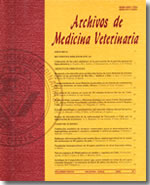Isolation of PRRS virus in Mexico: A clinical, serological and virological study
Main Article Content
Abstract
The PRRS disease is recognized in Mexico by the swine practitioners as an important problem within the national swine pathology since several years ago. The outbreaks derived from PRRS infections in susceptible populations brings about devastating economical effects. The purposes of this study were to identify the clinical signs in each farm and to compare them with others in order to distinguish a clinical displaying pattern to perform the syndromic integration on each farm and also to know the antibody level of the sampled farms and to classify them in terms of their S/P ratio (serum sample/positive control), and finally try to isolate the virus. Eight productive farms were selected where a clinical, serological and virological study was done in pigs of all ages as well as of all productive/physiological stages. An average of 100 serum samples from each farm were taken for the viral and serologic studies. The results showed that all the farms were seropositive in addition to the isolation of the virus nevertheless, only one farm showed reproductive failure. The virus was present in all farms, but it was revealed in different ways, this is why we could not establish a clinical displaying pattern since it was different within the 8 farms. In relation to the age and the productive/physiological stage from which the virus was isolated, it stands out the fact that it was more frequently found in sows on their sixth farrowing in 7 out of the 8 farms analysed; as well as in suckling and one month old piglets in 6 out of 8 farms. The latter suggests that the sixth farrowing sows as well as the suckling and one month old piglets are the most suitable animals to attempt the virus isolation.

